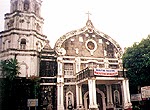Tourist Attractions
Bulacan is a first class province of the Philippines, located in the Central Luzon Region (Region III) in the island of Luzon, 16 km north of Metropolitan Manila (the nation's capital), and part of the Metro Luzon Urban Beltway Super Region. Bulacan was established 15 August 1578.
It has 569 barangays from 21 municipalities and three component cities (Malolos, the capital city; Meycauayan; and San Jose del Monte). Bulacan is located immediately north of Metro Manila. Bordering Bulacan are the provinces of Pampanga to the west, Nueva Ecija to the north, Aurora and Quezon to the east, and Metro Manila and Rizal to the south. Bulacan also lies on the north-eastern shore of Manila Bay.
 |
| Hill Top. Bulacan's Little Baguio |
 |
| Plaridel Catholic Church. A 400-year old Parish Church. |
In the 2010 census, Bulacan had a population of 3,124,433 people, the highest population in Region 3 and most populous province in the whole Philippines. Bulacan's most populated city is San Jose del Monte, the most populated municipality is Santa Maria while the least populated is Doña Remedios Trinidad.
In 1899, the historic Barasoain Church in Malolos was the birthplace of the First Constitutional Democracy in Asia. It is also the cradle of the nation's noble heroes, of great men and women; also home to many of the country's greatest artists, with a good number elevated as National Artists.
Today, Bulacan is among the most progressive provinces in the Philippines. Its people — the Bulaqueños (or Bulakenyo in Filipino)— are regarded as highly educated, enterprising and industrious. It is well known for the following industries: marble and marbleized limestone, jewelry, pyrotechnics, leather, aquaculture, meat and meat products, garments, furniture, high-value crops, sweets and native delicacies, and a wide variety of high-quality native products.
Bulacan has fast become an ideal tourist destination, owing to its vital role in Philippine history, and its rich heritage in culture and the arts.[citation needed] The province is popularly known for its historical sites; nostalgic old houses and churches; idyllic ecological attractions; religious attractions; colorful and enchanting festivals; swimming and various themed attractions; and a wide selection of elegant native crafts and sumptuous delicacies. It is also home to numerous resorts, hotels, restaurants, and other recreational facilities.
 |
| The monument was built in honor of Francisco “Baltazar” Balagtas, Father of tagalog poetry, author of the popular masterpiece “Florante at Laura.” |
Bulacan is bounded by Nueva Ecija on the north, Aurora (Dingalan) on the northeast, Quezon (General Nakar) on the east, Rizal (Rodriguez) on the southeast, Metro Manila (Valenzuela City, Malabon City, Navotas City, Caloocan City and Quezon City) on the south, Manila Bay on the southwest, and Pampanga on the west.
Several rivers irrigate the province of Bulacan; the largest one is that of Angat. Angat River passes through the towns of Norzagaray, Angat, Bustos, San Rafael, Baliuag, Plaridel, Pulilan, and Calumpit. It flow thence into the Pampanga River, goes out again, washes Hagonoy and loses itself in the mangroves. The banks of these rivers are very fertile and are covered with trees.


No comments:
Post a Comment
What is in your mind?